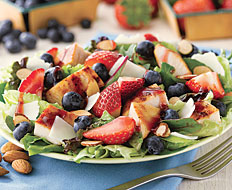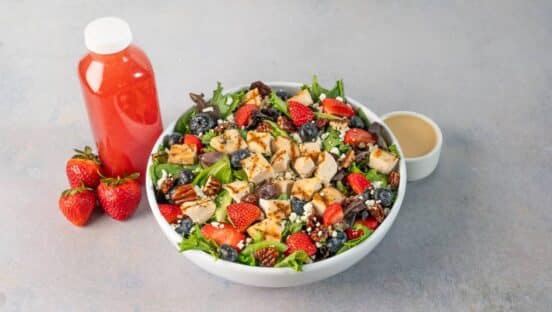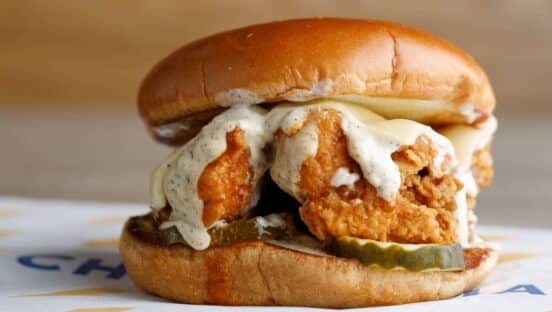As consumers increasingly seek healthy, great-tasting food, it seems that more chefs and restaurant operators are looking to fruit as a perfect ingredient for menu items.
The health benefits are obvious. Most fruit is low in fat, sodium, and calories; full of vitamins and minerals; and has no cholesterol. It also provides natural sweetness.
Fruit has been part of limited-service restaurants’ menus for decades, mostly in desserts or in beverages like orange juice or strawberry milkshakes. Now it’s expanding.
“There is a genuine response to consumers asking for healthier, fresher food,” says Dennis Lombardi, executive vice president of foodservice strategies at WD Partners, a food and retail design and consulting firm based in suburban Columbus, Ohio.
“As customers are slowly learning to eat better and make better choices, you find the restaurant industry is responding wholeheartedly.”
The result has been the introduction of more menu items that contain fruit.
But that doesn’t mean there’s no room for growth. According to a 2010 study by the NPD Group for the Produce for Better Health (pbh) Foundation, fruit is an underdeveloped ingredient at restaurants, with only 3 percent of all the nation’s fruit eaten there.
“It shows we have a way to go,” says Elizabeth Pivonka, president of the Delaware-based not-for-profit foundation, which wants to motivate people to eat fruit and vegetables.
The percentage would have been significantly higher had the study considered tomatoes as a fruit, which they are. For cooking purposes, however, tomatoes are largely considered vegetables, in part because they are savory rather than sweet.
The U.S. Department of Agriculture’s MyPlate dietary guidelines point out fruit’s importance. Half of an individual’s daily diet should consist of fruits and vegetables.
Therefore, fruit provides “a huge opportunity” for eateries, Pivonka says.
Restaurants that want to use more fresh fruit can take advantage of improvements to the fruit supply chain, says Dave Cope, CEO of Purfresh, a California company that provides safe options to purify, protect, and preserve fresh produce.
Fruit often takes weeks to get from the farm to market, and may be picked early in order to ripen in transit. Fruit often is sprayed with chemicals to maintain freshness.
Consumers, however, “increasingly want not only fresh food, but safe food with as few chemicals as possible,” Cope says. “New technology is helping that happen.”
While some restaurants are using more fresh fruit, others are finding success with the individually quick frozen (iqf) process, which captures the flavor, freshness, and texture of fruit by quickly freezing it.
All these fruit alternatives give operators a chance to differentiate themselves across the menu, from salads to soup and bread to beverages, Lombardi says. “What you’re seeing in fruit is a way to enhance all types of dishes.”
Diners are taking notice. A survey by the PBH Foundation last year noted that a quarter of the nation’s moms found it easier to get their families to eat fruit at limited-service restaurants than before. That’s up from 19 percent in 2008.
Pivonka credits this increase in part to McDonald’s, which recently vowed to include apple slices in all its Happy Meals and offers the Fruit ‘n Yogurt Parfait, with blueberries and strawberries, as a healthy snack option.
“McDonald’s has single-handedly done so much with fruit,” she says.
For much of the past decade, fruit has been “an integrated part” of McDonald’s pantry, says Dan Coudreaut, the company’s executive chef and senior director of culinary innovation.
McDonald’s introduced Apple Dippers—fresh sliced and peeled apples with a low-fat caramel dip—in late 2003. Next was a fruit and walnut salad, followed by various other items, including recent smoothies and oatmeal with fruit.
“Have we made a concerted effort to add more fruit to the menu? Yes,” Coudreaut says. “It’s in tune with what guests want. This is all part of a trend, because people are more and more exposed to having” fruit as part of their daily menu.
Other limited-service restaurants have added fresh fruit, too. Most of the bakery cafés and many quick serves have pieces of fruit (apples, bananas, or oranges) on the menu, while more than a dozen chains have fresh fruit cups and salads.
In 2004, Wendy’s was among the first fast feeders to offer a fresh fruit cup and the first to have a full fruit salad on the menu. But it didn’t last long.
“Consumers said they wanted it, but they didn’t flock to it,” says long-time company spokesman Denny Lynch. Now, considering the growing interest by consumers in fresh fruit items over recent years, “we were probably ahead of the game,” he says.
In the succeeding years, Wendy’s didn’t give up on fruit. The chain just decided to use items like apples, dried cranberries, and mandarin oranges as salad ingredients.
This summer, the company added a seasonal Berry Almond Chicken Salad, with strawberries and blueberries and a raspberry vinaigrette. The idea is to have the salad available from May through September, when the fruit is at its peak.
The strawberries and blueberries, which are also in a new parfait, are domestically sourced, which is quite a feat when nearly half of the fresh fruit in the U.S. is imported.
“We can get the strawberries from the fields to the restaurants in two to three days,” Lynch says. “Advances in distribution and technology are truly helping this process.”
Fruit is key to the menu at Corner Bakery, where more than a dozen items contain at least one fruit ingredient.
[pagebreak]
“We butcher a lot of fruit every day,” jokes Ric Scicchitano, senior vice president of food and beverage for the Dallas-based company. “If done right, fruit can be a great differentiator for a restaurant.”
One of the earliest items Scicchitano created for Corner Bakery was raisin pecan bread, which remains on the menu. Since then, fruit has only grown as an ingredient.
The Chilled Swiss Oatmeal, which is European-style muesli, has green apples, bananas, currants, and dried cranberries. The Fresh Berry Parfait features fresh seasonal berries, and the D.C. Chicken Salad uses currants and green apples.
But the most popular fruit at Corner Bakery is avocado. “It is one of the sexiest items right now,” Scicchitano says. “It’s been popular in California for years, and it’s grown in popularity around the rest of the country.”
Avocados are in the company’s top sandwich (Uptown Turkey on Harvest Toast), the No. 1 breakfast egg dish (Anaheim Scrambler), and a favorite salad (Southwest Avocado Wedge with jicama slaw).
Most Mexican restaurants use avocados to make guacamole, so it’s part of the menu in thousands of quick-service and fast-casual locations across the country. The fruit is also in sandwiches and salads at wichcraft, a 13-store chain based in New York that was founded by “Top Chef” judge Tom Colicchio.
Other fruit is part of creative menu ideas at wichcraft. The Heritage Smoked Ham and Cheddar sandwich includes chutney made from dates and almonds, while the Grilled Cheddar sandwich on the catering menu features pears and cranberry-pecan bread.
“We try to use fruit for natural sweetness,” says Jeffrey Zurofsky, president and partner at the company. “Sweetness in any food is part of creating balance in the flavor profile.”
Although unusual combinations in sandwiches and other menu items are becoming more acceptable to diners, there are also old, reliable combinations, such as wichcraft’s peanut butter and jelly sandwich that uses preserves with a high concentration of fruit.
“The sweetness balances the saltiness and fat of the peanut butter,” Zurofsky says.
Fruit has long been a favorite for flavoring beverages, and that’s expanding today because of the growth in smoothies.
“Fruit is at the core of what we do every day,” says Brian Lee, vice president of innovation and quality at Jamba Juice, which serves various fruit drinks.
The Emeryville, California–based chain’s smoothies use various berries, apples, bananas, mangos, oranges, passion fruit, peaches, pineapple, and more. Açai is in some beverages, and yumberry was offered last year.
“Folks are getting a little more adventuresome,” Lee says, explaining that tartness is one growing trend along with more “interest in the superfruits, which carry lots of antioxidants.”
In recent years, Jamba Juice’s menu has expanded with oatmeal, frozen yogurt, and baked goods, all of which rely in part on fruit ingredients. This summer, the company launched Fruit Refreshers, which meld coconut water with pineapple, mango, or strawberry lemonade.
The most notable operator adding smoothies has been McDonald’s, which already had a vast beverage line that included that old fruit-flavored standby, the strawberry milkshake.
McDonald’s mixed berry and strawberry banana smoothies were launched last summer, and a mango pineapple flavor was added this year.
Caribou Coffee also began a line of smoothies with four mixed-fruit varieties. The company uses fruit in its oatmeal, yogurt parfaits, and bakery items, as well.
“We have evolved certain areas to accentuate fruit ingredients,” says Alfredo Martel, senior vice president of marketing for the coffee chain, based in suburban Minneapolis. “The trend is for more natural flavors that are sweet, nutritious, and, hopefully, healthy.”
Increased acceptance of various fruits is leading to many new menu items.
“New fruits and flavors emerge, like pomegranate now,” Martel says. “Remember when kiwi was all the rage? It was not part of the American palate at the time. And as we look at more ethnic flavors, that exploration naturally lends itself to fruit, too.”
That’s the case at Eegee’s, a 23-unit, Tucson, Arizona–based sub sandwich chain that features smooth, slushy-like beverages. There are three regular flavors—lemon, strawberry, and piña colada (coconut and pineapple)—plus a new flavor each month.
Robert Jensen, director of operations, says the chain’s restaurants are constantly looking for new flavors, including exotic fruits. At times, customers have needed a little while to get used to some items.
“We did a mango lime about eight years ago, and it was about 50-50; half of the people liked it and half didn’t,” he says. “But when we did mango this May, people loved it.”
As fruit has grown across the quick-serve menu, it remains key to desserts, especially ice cream.
“Fruit with cream in any form has been popular for many, many years,” says Ray Karam, senior tastemaster at Cold Stone Creamery. “It adds dimension.”
Strawberries are the top fruit at Cold Stone, followed by blueberries and raspberries. Most fruit is individually quick frozen, giving the company access to a wide array of flavors at any time.
Although Americans have become more open to exotic fruits, they don’t always like those stand-alone flavors in ice cream, Karam says. “To make it mainstream, sometimes you have to mix it with other fruits or ingredients,” he says.
Among Cold Stone’s new creations this summer were Strawberry Basil and Mojito, both mixing sweet and savory in ways that customers are more willing to try today.
The future is likely to see even more menu innovations with fruit, says McDonald’s Coudreaut, because consumer demand requires it.
“My team, for instance, is constantly saying, ‘How can we get more produce in the menu?’” he says. “You don’t want to push guests farther than they want to go. At the same time, it’s apparent that we’d like to have more fruit, whenever possible.”











